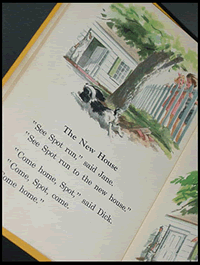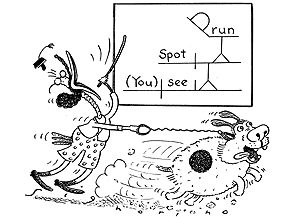November 11, 2007
Ask Language Log: See spot run
 Nic Bommarito wrote to ask about a famous sentence from the infamous Dick and Jane textbooks of the 1950s: "See Spot Run."
Nic Bommarito wrote to ask about a famous sentence from the infamous Dick and Jane textbooks of the 1950s: "See Spot Run."
I don't know how to explain what is happening in this sentence.'See' is an imperative but 'run' I can't explain.
Searching the internet, Nic found an analysis of this sentence on Cecil Adams' excellent site The Straight Dope. After considering three theories from "a survey of experts" and finding them wanting, Adams turns to his "trusty 1936 edition of A Writer's Manual and Workbook by Paul Kies", and finds a sentence diagram that "looks like the Flying Wallendas playing jai alai".
Adams leaves it there, after asking the gnomic question "This week sentence diagramming, next week world peace?" This might be taken to imply that an understanding of syntax must await the Messaiah, and it left Nic understandably puzzled as to whether the original question had been answered or not.
To Nic and any others who are interested, I recommend chapter 14 of the Cambridge Grammar of the English Language, "Non-finite and verbless clauses", where in section 5.4, he'll find see numbered among the verbs of class 3Bii, and learn that "run" in "See Spot run" is known as a bare infinitival.
These verbs, together with smell from Class 3Cii below, are the verbs of sensory perception. All take bare infinitivals, while [some of them] take a to-infinitival as well. For see we have the following possibilities:
[43] i a. We saw Kim leave the bank. b. *Kim was seen leave the bank. ii a. We saw Kim leaving the bank. b. Kim was seen leaving the bank. iii a. We saw Spurs beaten by United. b. ?Spurs were seen beaten by United. iv a. We saw him to be an imposter. b. He was seen to be an imposter. We put the to-infinitival last because this does not represent the primary sense: it is not a matter of sensory perception but of mental inference. In this construction, see behaves like the verbs of cognition/saying (Class 3Aii), following their pattern of favouring a matrix passive and the verb be in the subordinate clause, of allowing the perfect (He was seen to have altered the figures), and of alternating with the finite construction (We saw that he was an imposter).
The primary sense, illustrated in [43i-iii], involves two arguments, an experiencer and an stimulus (the situation perceived): Kim in [i-ii] thus does not represent an argument of see.
Just for grins, let's compare the four viewpoints presented in Cecil Adams' 1998 answer.
His first "expert" says that the sentence is simply "malformed" and should be replaced by "Did you see Spot running?". Adams, quite appropriately, rules this out as "cheating", since it pretends to answer the question by claiming that it never should have been posed in the first place.
The second "expert" says that Spot run is a "small clause", which Adams describes as "a piquant term brought to us courtesy of transformational grammar, a field of linguistics we might think of as sentence diagramming for adults". Adams is not satisfied by this answer, because he finds that after telling him that "[a] small clause consists of a noun phrase followed by some other kind of phrase" and that "[in] 'See Spot run,' Spot is the noun phrase and run is a verb phrase", he believes that "your transformational grammarians do not trouble themselves with such details as what kind of verb" run is.
This is more than a little unfair to modern linguists in general, and in particular to my former classmate Edwin Williams, who introduced the term "small clause" in his 1974 dissertation "Rule Ordering in Syntax", a work that was quite explicit about its theory of what kinds of entities make up a sentence like "See Spot run". If Cecil had managed to reach him, I'm sure that Edwin would have been happy to describe and explain the nature and distribution of verbs like run in such sentences -- and in descriptive terms, at least, Edwin's discussion would have been quite similar to the one that I've quoted above from CGEL.
On the other side, it's fair to complain that before the publication of CGEL in 2002, modern linguists had not provided a systematic and accessible account of English syntax. (Though I'm sure that Quirk, Greenbaum, Leech & Svartvik's Comprehensive Grammar also gives a clear and straightforward analysis of the "See Spot run" type of construction.) Edwin's dissertation would not be an easy read for an interested member of the general public -- and an effort to master the technicalities necessary to follow its details would be an exercise of mainly historical interest, since field's treatment of syntax has undergone several transformations and bifurcations of notation and terminology since 1974.
Adams' third "expert" presented an analysis somewhat like CGEL's, with slightly different terminology and an unnecessary generalization of the notion of "direct object":
Spot run is an "objective infinitive." Now we're getting somewhere. An infinitive is an uninflected verb form commonly beginning with to, as in to run. In an objective infinitive (and doesn't that sound like something you could get Unitarians to pray to?), the noun is modified by the infinitive, and the two parts together--in this case Spot run--are the direct object of the predicate, see. One may object: How can run be an infinitive? There's no to in front of it. My informant explained this by saying the to was "understood." "See Spot [to] run"? I don't think so.
This is again a bit unfair -- asking "How can run be an infinitive? There's no to in front of it." reminds me of the class of bad jokes "If you're a captain, where's your ship?"
And indeed, Adams is happy to take Paul Kiel's word for the notion that to, though it's the "sign of the infinitive," is "frequently omitted, especially after such verbs as help, make, bid, feel, see, hear, dare, need". And he adopts the associated sentence diagram as the background for the picture at the head of his entry:

Unfortunately, CGEL lacks evocative graphics. Nevertheless, pending messianic developments, it should be the go-to source for questions about English syntax.
Posted by Mark Liberman at November 11, 2007 08:21 AM